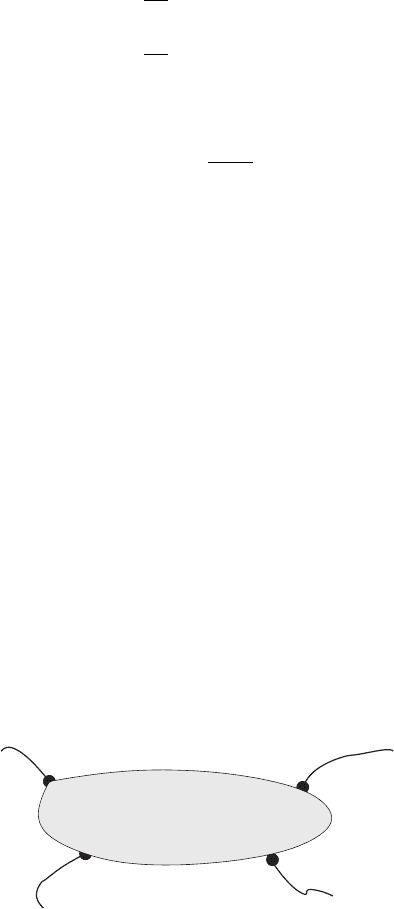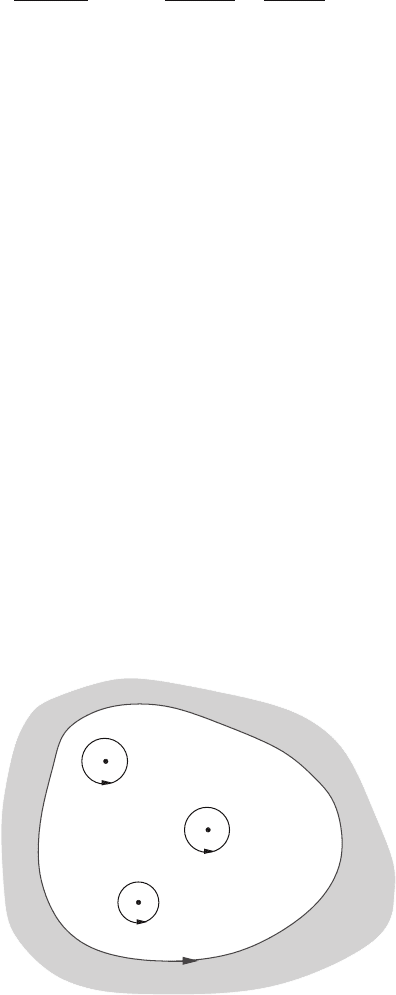Stone M., Goldbart P. Mathematics for Physics: A Guided Tour for Graduate Students
Подождите немного. Документ загружается.


17.1 Cauchy–Riemann equations 615
potential of a unit charge at w = i:
φ
1
+ iφ
2
=−
1
2π
(
ln(w − i ) − ln(w + i)
)
=−
1
2π
ln(e
iα
z).
Therefore
z = e
−iα
w − i
w + i
. (17.41)
We immediately verify that this works: we have |z|=1 when w is real, and z = 0
at w = i.
The difficulty with the physical argument is that it is not clear that a solution to the
point-charge electrostatics problem exists. In three dimensions, for example, there is no
solution when the boundary has a sharp inward directed spike. (We cannot physically
realize such a situation either: the electric field becomes unboundedly large near the tip of
a spike, and boundary charge will leak off and neutralize the point charge.) There might
well be analogous difficulties in two dimensions if the boundary of D is pathological.
However, the fact that there is a proof of the Riemann mapping theorem shows that
the two-dimensional electrostatics problem does always have a solution, at least in the
interior of D – even if the boundary is an infinite-length fractal. However, unless ∂D is
reasonably smooth the resulting Riemann map cannot be continuously extended to the
boundary. When the boundary of Disa smooth closed curve, then the boundary of D
will map one-to-one and continuously onto the boundary of the unit circle.
Exercise 17.1: Van der Pauw’s theorem.
3
This problem explains a practical method of
determining the conductivity σ of a material, given a sample in the form of a wafer
of uniform thickness d, but of irregular shape (Figure 17.4). In practice at the Phillips
company in Eindhoven, this was a wafer of semiconductor cut from an unmachined
boule.
A
B
D
C
Figure 17.4 A thin semiconductor wafer with attached leads.
3
L. J. Van der Pauw, Phillips Research Reps., 13 (1958) 1. See also A. M. Thompson, D. G. Lampard,
Nature, 177 (1956) 888, and D. G. Lampard. Proc. Inst. Elec. Eng. C., 104 (1957) 271, for the “calculable
capacitor”.
616 17 Complex analysis
We attach leads to point contacts A, B, C, D, taken in anticlockwise order, on the
periphery of the wafer and drive a current I
AB
from A to B. We record the potential
difference V
D
− V
C
and so find R
AB,DC
= (V
D
− V
C
)/I
AB
. Similarly we measure
R
BC,AD
. The current flow in the wafer is assumed to be two dimensional, and to obey
J =−(σ d)∇V , ∇·J = 0,
and n · J = 0 at the boundary (except at the current source and drain). The potential V
is therefore harmonic, with Neumann boundary conditions.
Van der Pauw claims that
exp{−πσdR
AB,DC
}+exp{−πσdR
BC,AD
}=1.
From this σ d can be found numerically.
(a) First show that Van der Pauw’s claim is true if the wafer were the entire upper
half-plane with A, B, C, D on the real axis with x
A
< x
B
< x
C
< x
D
.
(b) Next, taking care to consider the transformation of the current source terms and the
Neumann boundary conditions, show that the claim is invariant under conformal
maps, and, by mapping the wafer to the upper half-plane, show that it is true in
general.
17.2 Complex integration: Cauchy and Stokes
In this section we will define the integral of an analytic function, and make contact with
the exterior calculus from Chapters 11–13. The most obvious difference between the
real and complex integral is that in evaluating the definite integral of a function in the
complex plane we must specify the path along which we integrate. When this path of
integration is the boundary of a region, it is often called a contour from the use of the
word in the graphic arts to describe the outline of something. The integrals themselves
are then called contour integrals.
17.2.1 The complex integral
The complex integral
f (z )dz (17.42)
over a path may be defined by expanding out the real and imaginary parts
f (z )dz
def
=
(u + iv)(dx +idy) =
(udx − vdy) + i
(vdx + udy) (17.43)
and treating the two integrals on the right-hand side as standard vector-calculus line
integrals of the form
v · dr, one with v → (u, −v) and one with v → (v , u).

17.2 Complex integration: Cauchy and Stokes 617
z
1
z
2
2
N
1
z
N–1
z
N
= b
a=z
0
a
b
Figure 17.5 A chain approximation to the curve .
The complex integral can also be constructed as the limit of a Riemann sum in a manner
parallel to the definition of the real-variable Riemann integral of elementary calculus.
Replace the path with a chain composed of N line segments z
0
-to-z
1
, z
1
-to-z
2
, all the
way to z
N −1
-to-z
N
(Figure 17.5). Now let ξ
m
lie on the line segment joining z
m−1
and
z
m
. Then the integral
f (z )dz is the limit of the (Riemann) sum
S =
N
m=1
f (ξ
m
)(z
m
− z
m−1
) (17.44)
as N gets large and all the |z
m
− z
m−1
|→0. For this definition to make sense and be
useful, the limit must be independent of both how we chop up the curve and how we
select the points ξ
m
. This will be the case when the integration path is smooth and the
function being integrated is continuous.
The Riemann sum definition of the integral leads to a useful inequality: combining
the triangle inequality |a + b|≤|a|+|b| with |ab|=|a||b| we deduce that
!
!
!
!
!
N
m=1
f (ξ
m
)(z
m
− z
m−1
)
!
!
!
!
!
≤
N
m=1
|f (ξ
m
)(z
m
− z
m−1
)|
=
N
m=1
|f (ξ
m
)||(z
m
− z
m−1
)|. (17.45)
For sufficiently smooth curves the last sum converges to the real integral
|f (z )||dz|,
and we deduce that
!
!
!
!
f (z ) dz
!
!
!
!
≤
|f (z )||dz|. (17.46)
For curves that are smooth enough to have a well-defined length ||, we will have
|dz|=||. From this identification we conclude that if |f |≤M on , then we have
the Darboux inequality
!
!
!
!
f (z ) dz
!
!
!
!
≤ M ||. (17.47)
We shall find many uses for this inequality.

618 17 Complex analysis
The Riemann sum definition also makes it clear that if f (z) is the derivative of another
analytic function g(z), i.e.
f (z ) =
dg
dz
, (17.48)
then, for a smooth path from z = a to z = b, we have
f (z )dz = g(b) − g(a). (17.49)
This claim is established by approximating f (ξ
m
) ≈ (g(z
m
) − g(z
m−1
))/(z
m
− z
m−1
),
and observing that the resulting Riemann sum
N
m=1
g(z
m
) − g(z
m−1
)
(17.50)
telescopes. The approximation to the derivative will become accurate in the limit
|z
m
− z
m−1
|→0. Thus, when f (z) is the derivative of another function, the integral is
independent of the route that takes from a to b.
We shall see that any analytic function is (at least locally) the derivative of another
analytic function, and so this path independence holds generally – provided that we do
not try to move the integration contour over a place where f ceases to be differentiable.
This is the essence of what is known as Cauchy’s theorem – although, as with much of
complex analysis, the result was known to Gauss.
17.2.2 Cauchy’s theorem
Before we state and prove Cauchy’s theorem, we must introduce an orientation con-
vention and some traditional notation. Recall that a p-chain is a finite formal sum of
p-dimensional oriented surfaces or curves, and that a p-cycle is a p-chain whose
boundary vanishes: ∂ = 0. A 1-cycle that consists of only a single connected compo-
nent is a closed curve. We will mostly consider integrals over simple closed curves –
these being curves that do not self-intersect – or 1-cycles consisting of finite formal sums
of such curves. The orientation of a simple closed curve can be described by the sense,
clockwise or anticlockwise, in which we traverse it. We will adopt the convention that a
positively oriented curve is one such that the integration is performed in an anticlockwise
direction. The integral over a chain of oriented simple closed curves will be denoted
by the symbol
E
fdz.
We now establish Cauchy’s theorem by relating it to our previous work with exterior
derivatives: suppose that f is analytic with domain D, so that ∂
z
f = 0 within D.We
therefore have that the exterior derivative of f is
df = ∂
z
fdz+ ∂
z
fdz = ∂
z
fdz. (17.51)

17.2 Complex integration: Cauchy and Stokes 619
Now suppose that the simple closed curve is the boundary of a region ⊂ D. We can
exploit Stokes’ theorem to deduce that
F
=∂
f (z )dz =
d(f (z)dz) =
(∂
z
f ) dz ∧ dz = 0. (17.52)
The last integral is zero because dz ∧ dz = 0. We may state our result as:
Theorem (Cauchy, in modern language): The integral of an analytic function over a
1-cycle that is homologous to zero vanishes.
The zero result is only guaranteed if the function f is analytic throughout the region
. For example, if is the unit circle z = e
iθ
then
F
1
z
dz =
2π
0
e
−iθ
d
e
iθ
= i
2π
0
dθ = 2πi . (17.53)
Cauchy’s theorem is not applicable because 1/z is singular, i.e. not differentiable, at
z = 0. The formula (17.53) will hold for any contour homologous to the unit circle in
C \ 0, the complex plane punctured by the removal of the point z = 0. Thus
F
1
z
dz = 2π i (17.54)
for any contour that encloses the origin. We can deduce a rather remarkable formula
from (17.54): writing = ∂ with anticlockwise orientation, we use Stokes’ theorem
to obtain
F
∂
1
z
dz =
∂
z
1
z
d
z ∧ dz =
2πi,0∈ ,
0, 0 /∈ .
(17.55)
Since d
z ∧ dz = 2idx ∧ dy, we have established that
∂
z
1
z
= πδ(x)δ(y). (17.56)
This rather cryptic formula encodes one of the most useful results in mathematics.
Perhaps perversely, functions that are more singular than 1/z have vanishing integrals
about their singularities. With again the unit circle, we have
F
1
z
2
dz =
2π
0
e
−2iθ
d
e
iθ
= i
2π
0
e
−iθ
dθ = 0. (17.57)
The same is true for all higher integer powers:
F
1
z
n
dz = 0, n ≥ 2. (17.58)

620 17 Complex analysis
We can understand this vanishing in another way, by evaluating the integral as
F
1
z
n
dz =
F
d
dz
−
1
n − 1
1
z
n−1
dz =
−
1
n − 1
1
z
n−1
= 0, n = 1. (17.59)
Here, the notation
[
A
]
means the difference in the value of A at two ends of the inte-
gration path . For a closed curve the difference is zero because the two ends are at the
same point. This approach reinforces the fact that the complex integral can be computed
from the “anti-derivative” in the same way as the real-variable integral. We also see why
1/z is special. It is the derivative of ln z = ln |z|+i arg z, and ln z is not really a function,
as it is multivalued. In evaluating
[
ln z
]
we must follow the continuous evolution of
arg z as we traverse the contour. As the origin is within the contour, this angle increases
by 2π , and so
[
ln z
]
=
[
i arg z
]
= i
arg e
2πi
− arg e
0i
= 2πi. (17.60)
Exercise 17.2: Suppose f (z) is analytic in a simply connected domain D, and z
0
∈ D.
Set g(z) =
z
z
0
f (z ) dz along some path in D from z
0
to z. Use the path-independence of
the integral to compute the derivative of g(z) and show that
f (z ) =
dg
dz
.
This confirms our earlier claim that any analytic function is the derivative of some other
analytic function.
Exercise 17.3: The “D-bar” problem: Suppose we are given a simply connected domain
, and a function f (z,
z) defined on it, and wish to find a function F(z,
z) such that
∂F(z,
z)
∂z
= f (z,
z), (z, z) ∈ .
Use (17.56) to argue formally that the general solution is
F(ζ ,
¯
ζ) =−
1
π
f (z , z)
z − ζ
dx ∧ dy + g(ζ ),
where g(ζ ) is an arbitrary analytic function. This result can be shown to be correct by
more rigorous reasoning.
17.2.3 The residue theorem
The essential tool for computations with complex integrals is provided by the residue
theorem. With the aid of this theorem, the evaluation of contour integrals becomes easy.
All one has to do is identify points at which the function being integrated blows up, and
examine just how it blows up.

17.2 Complex integration: Cauchy and Stokes 621
If, near the point z
i
, the function can be written
f (z ) =
a
(i)
N
(z − z
i
)
N
+···+
a
(i)
2
(z − z
i
)
2
+
a
(i)
1
(z − z
i
)
g
(i)
(z), (17.61)
where g
(i)
(z) is analytic and non-zero at z
i
, then f (z) has a pole of order N at z
i
.IfN = 1
then f (z) is said to have a simple pole at z
i
. We can normalize g
(i)
(z) so that g
(i)
(z
i
) = 1,
and then the coefficient, a
(i)
1
,of1/(z − z
i
) is called the residue of the pole at z
i
. The
coefficients of the more singular terms do not influence the result of the integral, but N
must be finite for the singularity to be called a pole.
Theorem: Let the function f (z) be analytic within and on the boundary = ∂Dofa
simply connected domain D, with the exception of a finite number of points at which
f (z ) has poles. Then
F
f (z ) dz =
poles ∈ D
2πi (residue at pole), (17.62)
the integral being traversed in the positive (anticlockwise) sense.
We prove the residue theorem by drawing small circles C
i
about each singular point
z
i
in D (Figure 17.6).
We now assert that
F
f (z ) dz =
i
F
C
i
f (z ) dz, (17.63)
because the 1-cycle
C ≡ −
i
C
i
= ∂ (17.64)
z
3
z
2
z
1
D
C
1
C
2
C
3
Figure 17.6 Circles for the residue theorem.

622 17 Complex analysis
is the boundary of a region in which f is analytic, and hence C is homologous to zero.
If we make the radius R
i
of the circle C
i
sufficiently small, we may replace each g
(i)
(z)
by its limit g
(i)
(z
i
) = 1, and so take
f (z ) →
a
(i)
1
(z − z
i
)
+
a
(i)
2
(z − z
i
)
2
+···+
a
(i)
N
(z − z
i
)
N
g
(i)
(z
i
)
=
a
(i)
1
(z − z
i
)
+
a
(i)
2
(z − z
i
)
2
+···+
a
(i)
N
(z − z
i
)
N
, (17.65)
on C
i
. We then evaluate the integral over C
i
by using our previous results to get
F
C
i
f (z ) dz = 2πia
(i)
1
. (17.66)
The integral around is therefore equal to 2πi
,
i
a
(i)
1
.
The restriction to contours containing only finitely many poles arises for two reasons:
firstly, with infinitely many poles, the sum over i might not converge; secondly, there
may be a point whose every neighbourhood contains infinitely many of the poles, and
there our construction of drawing circles around each individual pole would not be
possible.
Exercise 17.4: Poisson’s formula. The function f (z) is analytic in |z| < R
. Prove that
if |a| < R < R
,
f (a) =
1
2πi
F
|z|=R
R
2
−¯aa
(z − a)(R
2
−¯az)
f (z )dz.
Deduce that, for 0 < r < R,
f (re
iθ
) =
1
2π
2π
0
R
2
− r
2
R
2
− 2Rr cos(θ − φ) + r
2
f (Re
iφ
)dφ.
Show that this formula solves the boundary value problem for Laplace’s equation in the
disc |z| < R.
Exercise 17.5: Bergman kernel. The Hilbert space of analytic functions on a domain D
with inner product
f , g=
D
¯
f g dxdy
is called the Bergman
4
space of D.
4
This space should not be confused with Bargmann–Fock space which is the space of analytic functions on
the entirety of C with inner product
f , g=
C
e
−|z|
2
¯
fgd
2
z.
Stefan Bergman and Valentine Bargmann are two different people.

17.2 Complex integration: Cauchy and Stokes 623
(a) Suppose that ϕ
n
(z), n = 0, 1, 2, ..., are a complete set of orthonormal functions on
the Bergman space. Show that
K(ζ , z) =
∞
m=0
ϕ
m
(ζ )ϕ
m
(z)
has the property that
g(ζ ) =
D
K(ζ , z)g(z) dxdy
for any function g analytic in D. Thus K(ζ , z) plays the role of the delta function
on the space of analytic functions on D. This object is called the reproducing or
Bergman kernel. By taking g(z) = ϕ
n
(z), show that it is the unique integral kernel
with the reproducing property.
(b) Consider the case of D being the unit circle. Use the Gramm–Schmidt procedure to
construct an orthonormal set from the functions z
n
, n = 0, 1, 2, ...Use the result of
part (a) to conjecture (because we have not proved that the set is complete) that, for
the unit circle,
K(ζ , z) =
1
π
1
(1 − ζ ¯z)
2
.
(c) For any smooth, complex valued, function g defined on a domain D and its boundary,
use Stokes’ theorem to show that
D
∂
z
g(z, z)dxdy =
1
2i
F
∂D
g(z, z)dz.
Use this to verify that the K(ζ , z) you constructed in part (b) is indeed a (and hence
“the”) reproducing kernel.
(d) Now suppose that D is a simply connected domain whose boundary ∂D is a smooth
curve. We know from the Riemann mapping theorem that there exists an analytic
function f (z) = f (z; ζ) that maps D onto the interior of the unit circle in such a
way that f (ζ ) = 0 and f
(ζ ) is real and non-zero. Show that if we set K(ζ , z) =
f
(z)f
(ζ )/π, then, by using part (c) together with the residue theorem to evaluate
the integral over the boundary, we have
g(ζ ) =
D
K(ζ , z)g(z) dxdy.
This K(ζ , z) must therefore be the reproducing kernel. We see that if we know K we
can recover the map f from
f
(z; ζ) =
<
π
K(ζ , ζ)
K(z, ζ).

624 17 Complex analysis
(e) Apply the formula from part (d) to the unit circle, and so deduce that
f (z ; ζ) =
z − ζ
1 −
¯
ζ z
is the unique function that maps the unit circle onto itself with the point ζ mapping
to the origin and with the horizontal direction through ζ remaining horizontal.
17.3 Applications
We now know enough about complex variables to work through some interesting
applications, including the mechanism by which an aeroplane flies.
17.3.1 Two-dimensional vector calculus
It is often convenient to use complex coordinates for vectors and tensors. In these
coordinates the standard metric on R
2
becomes
“ds
2
” = dx ⊗ dx + dy ⊗dy
= d
z ⊗ dz
= g
zz
dz ⊗ dz + g
zz
dz ⊗ dz + g
zz
dz ⊗ dz + g
zz
dz ⊗ dz, (17.67)
so the complex coordinate components of the metric tensor are g
zz
= g
zz
= 0, g
zz
=
g
zz
=
1
2
. The inverse metric tensor is g
zz
= g
zz
= 2, g
zz
= g
zz
= 0.
In these coordinates the Laplacian is
∇
2
= g
ij
∂
2
ij
= 2(∂
z
∂
z
+ ∂
z
∂
z
). (17.68)
When f has singularities, it is not safe to assume that ∂
z
∂
z
f = ∂
z
∂
z
f . For example, from
∂
z
1
z
= πδ
2
(x, y), (17.69)
we deduce that
∂
z
∂
z
ln z = πδ
2
(x, y). (17.70)
When we evaluate the derivatives in the opposite order, however, we have
∂
z
∂
z
ln z = 0. (17.71)
